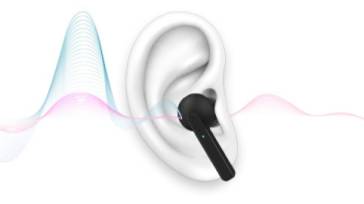To make your speaker sound loud enough, this key technology behind it is very important
Time:2024-01-18
Views:360
In today‘s consumer electronics market, micro speakers have been widely used in various devices, including gaming devices, smart home IoT devices, and wearable devices. Although it is often annoying to turn on the sound of private electronic products in public, when making a purchase, you will naturally prefer those that have a wider range of loudness while ensuring fidelity. How to improve the loudness and bass response of micro speakers has become the main design consideration for many audio designers.

 By adopting integrated IV (current and voltage) detection technology and ADI‘s proprietary DSM algorithm, the MAX98390 can drive the speaker to its maximum limit and provide overshoot and overheating protection, easily addressing the above design challenges. The thermal protection function of DSM devices enables designers to safely and stably drive speakers, breaking through rated power limits and achieving maximum volume. DSM diaphragm protection allows designers to drive the speaker to the specified limit of its diaphragm, breaking through the lower limit of resonant frequency and improving low-frequency response (two octaves).
By adopting integrated IV (current and voltage) detection technology and ADI‘s proprietary DSM algorithm, the MAX98390 can drive the speaker to its maximum limit and provide overshoot and overheating protection, easily addressing the above design challenges. The thermal protection function of DSM devices enables designers to safely and stably drive speakers, breaking through rated power limits and achieving maximum volume. DSM diaphragm protection allows designers to drive the speaker to the specified limit of its diaphragm, breaking through the lower limit of resonant frequency and improving low-frequency response (two octaves).
 In summary, the MAX98390 can bring several advantages to micro speakers: higher volume and bass sound effects, with a volume increase of up to 2.5 times (sound pressure level) compared to traditional 5V amplifiers, low-frequency range expansion of 2 octaves, and small-sized packaging; Easy to use, with ADI‘s new DSM Sound Studio software GUI, the system functions can be quickly demonstrated, allowing designers to clearly hear the application effects of DSM in just a few minutes. It is easy to analyze and prototype their speakers, significantly reducing design time and workload; Industry leading power consumption: Provides the lowest static power consumption in the current market, with a peak efficiency of up to 86% for boost type D-class amplifiers. With ADI‘s Perceived Power Reduction (PPR) patented algorithm, it can further increase power by 25% without losing audio fidelity. The minimum static power consumption is only 24mW, effectively extending battery life without reducing fidelity.
In summary, the MAX98390 can bring several advantages to micro speakers: higher volume and bass sound effects, with a volume increase of up to 2.5 times (sound pressure level) compared to traditional 5V amplifiers, low-frequency range expansion of 2 octaves, and small-sized packaging; Easy to use, with ADI‘s new DSM Sound Studio software GUI, the system functions can be quickly demonstrated, allowing designers to clearly hear the application effects of DSM in just a few minutes. It is easy to analyze and prototype their speakers, significantly reducing design time and workload; Industry leading power consumption: Provides the lowest static power consumption in the current market, with a peak efficiency of up to 86% for boost type D-class amplifiers. With ADI‘s Perceived Power Reduction (PPR) patented algorithm, it can further increase power by 25% without losing audio fidelity. The minimum static power consumption is only 24mW, effectively extending battery life without reducing fidelity.
Although these miniature speakers are compact in size, their basic components - diaphragm, voice coil, and magnet - are no different from traditional speakers. However, due to its smaller component volume and simpler structure, its overall appearance is also more compact and lightweight. However, the small size of micro speakers also brings some challenges. Its volume (sound pressure level) and bass response are usually limited because the smaller the speaker, the higher the resonant frequency, resulting in bass attenuation and weaker sound performance. However, by continuously monitoring and protecting the speaker from the effects of fault conditions, the volume and bass response of the speaker can be significantly improved.
In the application of micro speakers, the reliability challenges faced by devices have undergone significant changes compared to previous large-sized speakers: the coil temperature of micro speakers, such as in enclosed mobile phones, may reach up to 100 degrees Celsius, and the vibration amplitude of the diaphragm may also reach the mechanical limit (exceeding the limit will result in coil collision with the magnetic circuit or diaphragm collision with the roof protection cover).
Standard amplifiers cannot monitor and protect speakers from the effects of these two conditions, so the rated power of speakers is often conservatively set. The intelligent driver chip can calculate the impedance curve of the speaker by real-time monitoring the voltage and current of the speaker driving signal, and further derive the resonant frequency, amplitude, and temperature rise of the speaker (or module). These parameters will dynamically change due to different signals and environmental changes.
Here, ADI‘s patented Dynamic Speaker Management (DSM) ™) Technology can play a crucial role. DSM technology provides a safe way to drive micro speakers beyond the specified maximum rated power. The DSM algorithm can increase the volume (sound pressure level) by up to 2.5 times and extend the bass response to up to two octaves below the resonant frequency, while achieving excellent power efficiency.

Providing over shock and over heat protection, MAX98390 drives the speaker to the maximum limit
Today‘s consumer devices require speakers to adapt to smaller space sizes, leading to an increasing number of applications adopting micro speakers. The smaller the volume of the speaker, the lower the volume or sound pressure level (SPL), and the higher the resonant frequency, resulting in bass attenuation. By increasing the drive of the micro speaker to increase volume and low-frequency response, it is easy to cause overheating and excessive diaphragm oscillation, which can damage the micro speaker.
MAX98390 is a boost type digital DG class DSM smart amplifier, packaged in a 6.3mm2 package, which safely drives micro speakers with typically low rated power (up to about 3W) to higher power (up to 5.1W), fully unleashing the full audio potential of the system. Meanwhile, it can also be used in conjunction with 5W speakers to further enhance volume and bass effects.


Quickly design intelligent amplifier solutions using DSM Sound Studio GUI
In order to effectively protect the speaker, amplifier algorithms must be based on a thorough understanding of the speaker‘s characteristics, such as resonant frequency, diaphragm swing limits, and voice coil thermal protection. Traditionally, designers must go through a time-consuming and complex feature analysis process, or rely on supplier support to perform feature analysis on their speakers and their casings. Due to the fact that most projects use different speakers during the prototype development phase, suppliers need to provide support or require special equipment and expertise for several weeks, further increasing the design challenges.
But with the help of ADI‘s DSM Sound Studio GUI, this process has become unprecedentedly simple and fast, requiring less than 3 minutes to describe and customize the speaker protection algorithm. DSM Sound Studio is a GUI tool used in MAX98390 for speaker parameter extraction, tuning, and custom DSM settings. In addition, another GUI, MAX98390C/D evaluation software, can be used to change the configuration of the amplifier, such as boost voltage, current limiting value, etc.
DSM Sound Studio supports fast demonstrations, ultra fast speaker characterization, tuning, and easy evaluation of different speakers and tunes. DSM Sound Studio V2 provides more detailed assistance, optimized parameter extraction, and richer stereo features to help complete simple self guided designs, achieving a better user experience for users.
MAX98390 helps customers quickly and easily perform feature analysis on various speakers through the easy-to-use DSM Sound Studio GUI, significantly reducing design time. Combined with the thermal protection function of DSM, there is no need for complex programming, and the maximum volume can be achieved within a wide frequency range in just a few minutes.
|
Disclaimer: This article is transferred from other platforms and does not represent the views and positions of this site. If there is any infringement or objection, please contact us to delete it. thank you! |











